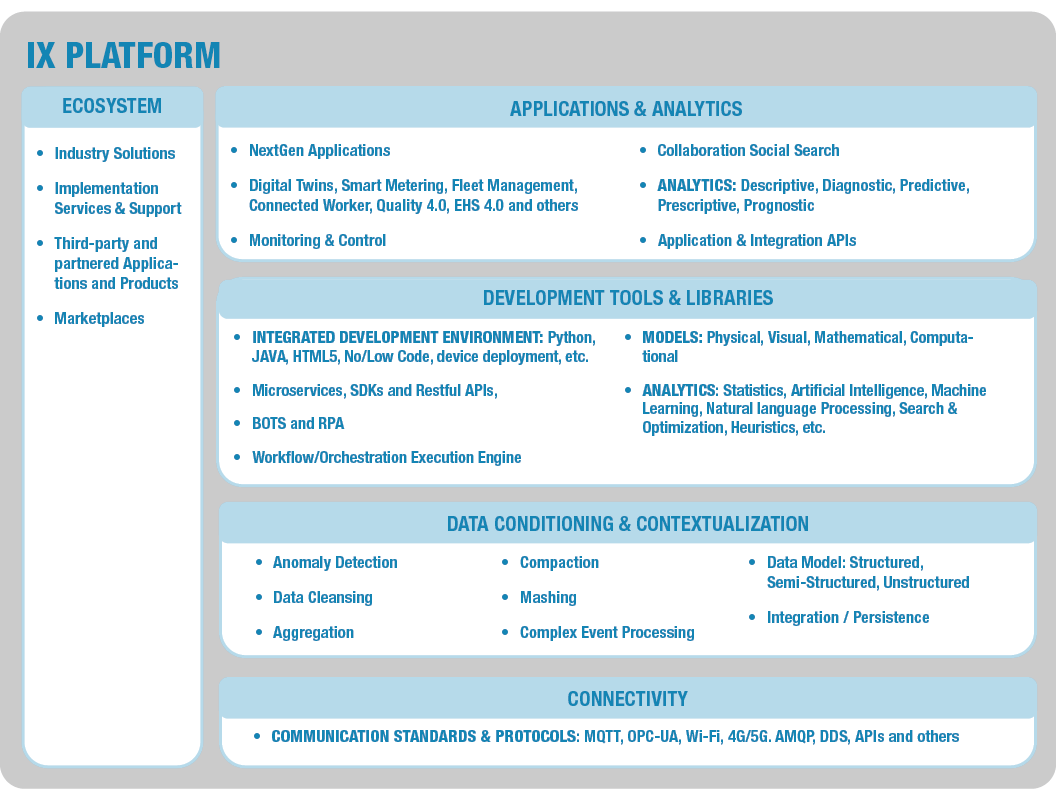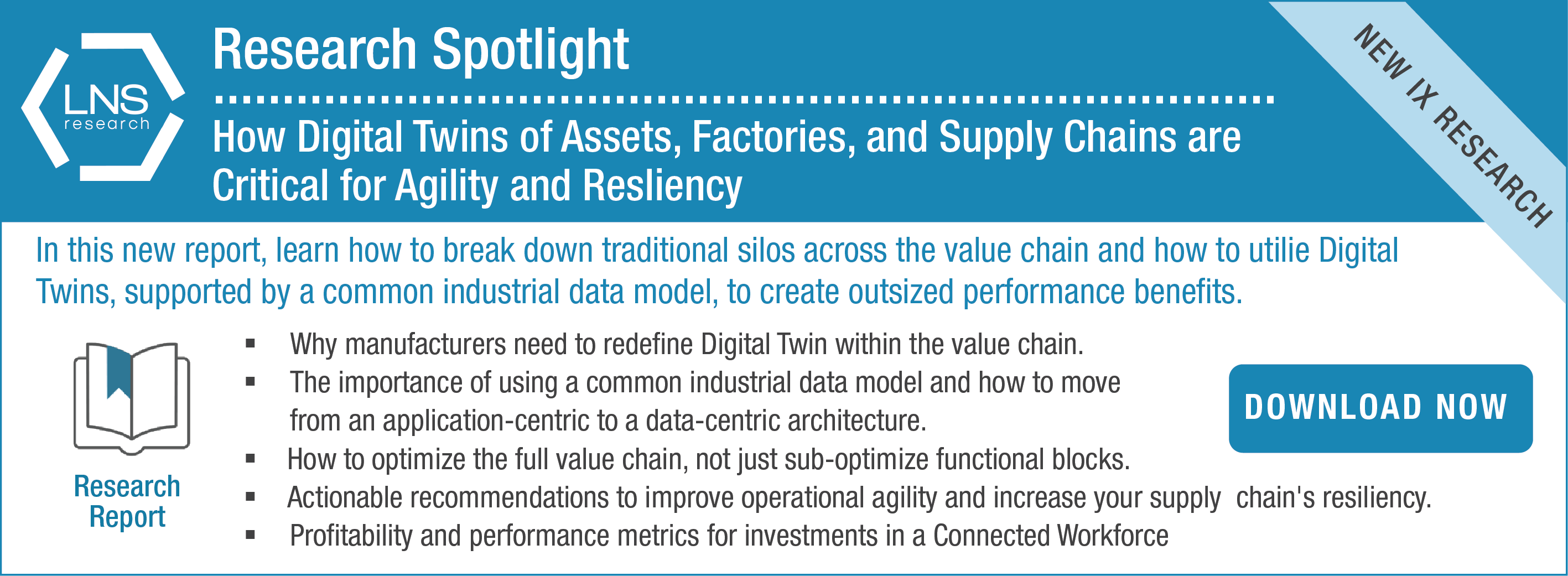LNS Research was the first to define an Industrial Internet of Things (IIoT) Platform in 2014. Our blog post continues to get strong search engine placement, readership, and inquiry. But the vision and definition were incomplete; the IIoT is not a catch all – it is focused on industrial device connectivity, management, data collection, and edge analytics – but enabling transformation takes much more.
Should a company be forced to deploy multiple platforms as additional technologies emerge like AI/ML, AR/VR, No-Code/Low-Code, and more? And can the original definition of the IIoT Platform scale to the breadth of required use cases to drive Industrial Transformation (IX)? We think not. For these reasons and more, we believe it is time for industry to move beyond IIoT Platforms to IX Platforms.
The IX Platform
In 2020, LNS Research redefined the market with the release of our Industrial Transformation (IX) Reference Architecture and in a three part series defined the different architectural and vendor paths industrial enterprises could execute to deploy and IX Architecture, including the IX Platform.
An IX Platform is a core means to deliver functionality across much of the LNS Research IX Reference Architecture with a heavy focus on the development environment:
IX Platforms Vendors offer a Platform as a Service (PaaS) to customers that includes a broad set of IX Reference Architecture capabilities (including data models and connectivity), can run on private or public cloud instances, support hybrid cloud architectures, add advanced analytical capabilities like AI/ML, and provide a no-code/low code app development environment and/or app store for other third-party developers to offer applications across a broad set of the IX landscape, including operations, assets, products, supply chain, customer experience, and connected worker among others.
IX Platforms include the needed tools for quickly and easily creating new applications. Whether these are “development” or “enablement” tools is a matter of semantics. All vendors are seeking to enable less technical users to create these mashup software applications and are promoting “low code” or “no-code” capabilities. Yet, sophisticated applications typically require a sophisticated understanding of IT/OT systems and programming and/or data science.
IX Platforms also are defined by their capabilities in other sub-domains of the IX Reference Architecture. IX Platforms include (directly or via partnership):
- A broad set of statistical and optimization tools to monitor and analyze structured, semi-structured, and unstructured data for enabling unprecedented insights.
- Data Conditioning and Contextualization
- Data Connectivity, Transport, and Industrial Cyber Security
- IaaS typically via a hyperscaler
The IX Platform is the key technology to execute a PaaS, “Vendor Ecosystem” architectural approach as outlined in the second Research Spotlight in the Architectural series. That Spotlight also outlines core and differentiating capabilities across IX Platforms. The series overall provides advice to manufacturers on whether taking an architectural approach that includes an IX Platform is right for them.
Developing Two Types of Applications
Looking at requirements for industrial organizations, we see two broad types of applications being developed on top of IX Platforms that are leveraging platform capabilities like search, collaboration, device connectivity, microservices, APIs, Digital Twins, and more.
- Monitoring and analytics applications typically leverage AI/ML along with other traditional analytics models and are being deployed to optimize performance across typical IX use cases like assets, operations, engineering, supply chain, service, and assets. These applications are all about deriving new insights for all sorts of data:
-
- Time Series data from data historians and devices.
- Structured data from all the enterprise applications deployed across the environment.
- Unstructured data from video, social media etc.
By leveraging existing and new data sources, IX Platforms are building Big Data solutions to long standing problems across manufacturing. Essentially, IX Platforms are being used to associate mass amounts of data from both within the enterprise and from outside the enterprise to derive new insights.
- Control and execution applications are being used to “wrap and extend” existing operational technology and fill in all the gaps across the plant and connected value chain. It is not uncommon for manufacturers to have hundreds of applications across a single manufacturing plant from ERP to MES/MOM to automation. Many of these applications are custom built in Access, Excel, or JAVA and are difficult to maintain and virtually impossible to roll out to other plants. IX Platforms are being deployed to replace these applications (Andon Boards, Work Instructions, Line Changes) with a centrally supportable tool. These applications may have a significant monitoring/ analytics capability but also an execution/control component. The challenge for manufacturers and IX Platform vendors is to enable a company to deploy all of these point solutions in a way that moves the manufacturer toward a comprehensive solution on a plant-wide data model.
The Evolution of the IX Platform Vendor Ecosystem
In many ways, the IIoT market was originally brought to fruition by GE Digital and the company’s active promotion of the Industrial Internet and Predix Platform for manufacturers to create new solutions and new business models. Over time, many start-ups and other industry stalwarts entered the market. We noted in a blog post the dramatic market dynamics around IIoT leading to an increasing focus on more packaged applications.
But we have now entered the second act of vendor development; many of the initial entrants having pulled back or launched second generation solutions, and many of the newer startups deploying a set of underlying capabilities and application footprints well beyond just the IIoT and closely aligning to our new IX definition.
Choosing the Right Path
If your organization is questioning if a platform approach to IX is appropriate for your organization, we have new research here that can help answer the question. This is an important decision that will have long-term consequences and we have seen many companies take the wrong path – choosing a best-of-breed or build-it-yourself strategy when a platform approach would have been better suited – and vice versus.
And, if you have already chosen the platform path, our forthcoming IX Platform Solution Selection Guide will help you short-list the right set of vendors for your organization’s specific requirements.
